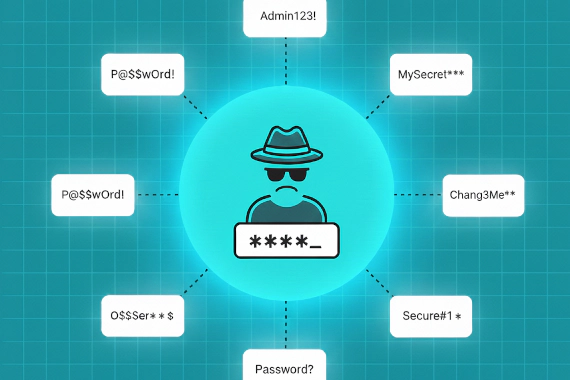
How to Prevent Password Spraying Attacks
Account Takeover Authentication Credential Monitoring
What Is Password Spraying? Account lockout policies exist to stop password guessing. Attackers adapted. Password …

FACT: The average cost of a healthcare data breach was $9.77 million in 2024.
These incidents have become an existential threat to healthcare providers.
In particular, smaller organizations may never recover after a breach.
In this post, we’ll cover the consequences of a data breach in the healthcare industry, as well as how organizations can prevent attacks.
But first, let’s talk about why the industry is especially vulnerable to attacks.
There are a number of factors that interplay that make the healthcare sector particularly vulnerable to cybersecurity attacks.
The most significant driver is the extraordinary value of healthcare data on the black market.
A single medical record can sell for hundreds of dollars, far more than credit card information.
This is because healthcare records contain personal, financial, and medical details that can be exploited for insurance fraud, identity theft, and blackmail.
This alone makes healthcare organizations an attractive target for cybercriminals.
Legacy systems are another common factor.
Many healthcare institutions run outdated software and medical devices that use obsolete operating systems.
Updating or replacing these systems is complicated due to regulatory requirements, cost constraints, and the need to maintain continuous patient care.
Human error remains a constant challenge as well.
Healthcare professionals, focused primarily on patient care, may inadvertently bypass security protocols or fall victim to phishing attacks.
The high-stress environment of most healthcare settings often leads to security shortcuts, like sharing passwords or leaving sessions unlocked when rushing between patients.
Interconnected healthcare systems also expand the attack surface.
Electronic Health Records (EHRs) must be accessible across different departments and institutions to facilitate patient care.
This creates numerous potential entry points for attackers.
Third-party vendors, from billing services to medical device manufacturers, can introduce additional vulnerabilities into the healthcare ecosystem.
Many healthcare organizations, particularly smaller clinics and rural hospitals, lack dedicated cybersecurity staff.
As a result, they struggle to implement basic security defenses (like patching) while balancing their primary mission of patient care with limited budgets.
These factors combine to make healthcare organizations prime targets, leading to significant financial consequences when breaches occur.
A data breach in the healthcare industry can have staggering financial implications for years after the incident.
Immediate breach response costs are substantial, often running into millions of dollars.
Organizations must invest in forensic investigations, emergency IT services, and crisis management teams.
The regulatory penalties can be significant.
Under HIPAA, fines can reach $1.5 million per violation category per year.
The Office for Civil Rights (OCR) has increasingly taken an aggressive approach, with some organizations facing multi-million dollar settlements.
For instance, Anthem’s 2015 data breach resulted in a record $16 million HIPAA settlement.
Legal consequences often dwarf regulatory fines.
Class-action lawsuits from affected patients are common.
Healthcare organizations can face litigation from business partners, insurance companies, and shareholders as well.
Legal defense costs alone can run into millions, while settlements can reach tens or even hundreds of millions of dollars.
Long-term business impact includes lost revenue from patient churn, as studies show that up to 40% of patients consider switching providers after a breach.
Organizations typically see increased insurance premiums and may struggle to maintain or secure cyber insurance coverage.
Some face downgrades in credit ratings, making future capital more expensive.
Recovery and remediation expenses are substantial.
Organizations must invest in new security infrastructure, conduct comprehensive system audits, retrain staff, and often hire additional cybersecurity personnel.
These costs can strain operational budgets for years following a breach.
Many healthcare organizations underestimate the indirect financial impact of reputational damage.
Lost business opportunities, decreased patient trust, and difficulty in recruiting top talent can create financial repercussions that are hard to quantify but significantly impact the bottom line.
The total cost of a healthcare data breach is significantly higher than other industries.
For smaller healthcare providers, these costs can be astronomical.
In many cases, a data breach can result in a forced closure or merger.
Here are the primary causes of data breaches in the healthcare industry:
We’ve already discussed the financial consequences of a data breach, so let’s now discuss the other impacts they have.
Healthcare breaches can devastate patients’ lives in a number of ways.
Medical identity theft enables criminals to receive care under stolen identities, potentially corrupting victims’ medical records with incorrect blood types, allergies, or medical conditions.
These errors could lead to life-threatening medical mistakes.
Patients may face years of dealing with fraudulent medical bills and insurance claims.
Their exposed personal health information could also lead to discrimination or even blackmail.
When breaches happen, healthcare organizations often face significant operational challenges.
Critical systems may need to be taken offline for investigation and remediation.
This can force staff to revert to paper records and manual processes.
The disruption can delay patient care, postpone procedures, and create dangerous gaps in access to medical histories.
During ransomware attacks, hospitals have been forced to divert emergency patients to other facilities, potentially risking lives due to delayed treatment.
Major breaches often trigger increased regulatory scrutiny across the entire healthcare sector.
This can lead to stricter compliance requirements and more frequent audits.
This creates an additional burden for all healthcare organizations, even those not directly affected by the breach.
The industry also typically sees increased cyber insurance premiums and more stringent underwriting requirements.
Perhaps the most harmful consequence is the loss of trust.
When patients lose confidence in a provider’s ability to protect their sensitive information, they may withhold crucial health information from their providers.
They may delay seeking medical care and provide inaccurate information to protect their privacy.
After a breach, patients are also more likely to avoid participating in medical research or health information exchanges.
Organizations may need to deal with business consequences that extend years beyond the initial breach.
These include loss of competitive advantage as patients choose more secure providers.
Difficulty maintaining business partnerships due to perceived security risks.
Challenges in securing funding or favorable loan terms.
Reduced ability to participate in health information exchanges.
Ongoing costs related to security improvements and monitoring. Increased oversight and reporting requirements from regulators
Beyond immediate fines, organizations often face years of increased regulatory oversight.
These often include mandatory external audits and new reporting requirements to regulatory bodies.
They may be forced to implement specific security tools as well.
After a breach, healthcare organizations often have new monitoring and documentation requirements.
Large-scale breaches can have broader public health implications.
Healthcare organizations tend to become more protective of patient data in response to data breaches.
This may reduce information sharing that’s valuable for public health monitoring, research, and emergency response.
This can impact our ability to track disease outbreaks, conduct medical research, and respond to public health crises effectively.
Given these consequences, healthcare organizations must be proactive in preventing a data breach.
Here are some essential strategies every healthcare organization should implement.

Account Takeover Authentication Credential Monitoring
What Is Password Spraying? Account lockout policies exist to stop password guessing. Attackers adapted. Password …

Phishing Account Takeover Dark Web Monitoring
What Are Impersonation Attacks? Most phishing emails are easy to spot. Bad grammar, suspicious links, requests from …